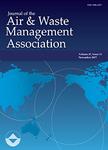版权所有:内蒙古大学图书馆 技术提供:维普资讯• 智图
内蒙古自治区呼和浩特市赛罕区大学西街235号 邮编: 010021

作者机构:Product and Process Design Research Group Chemical Engineering Department Vaal University of Technology Vanderbijlpark South Africa
出 版 物:《Journal of the Air & Waste Management Association》 (空气和废物管理协会杂志)
年 卷 期:2018年第68卷第2期
页 面:93页
学科分类:0830[工学-环境科学与工程(可授工学、理学、农学学位)] 08[工学]
摘 要:The disposal of industrial brine sludge waste (IBSW) in chlor-alkali plants can be avoided by utilization of IBSW as a sorbent in wet flue gas desulfurization (FGD). The shrinking core model was used to determine the dissolution kinetics of IBSW, which is a vital step in wet FGD. The effects of solid-to-liquid ratio (m/v), temperature, pH, particle size, and stirring speed on the conversion and dissolution rate constant are determined. The conversion and dissolution rate constant decreases as the pH, particle size, and solid-to-liquid ratio are increased and increases as the temperature, concentration of acid, and stirring speed are increased. The sorbents before and after dissolution were characterized using x-ray fluorescence (XRF), x-ray diffraction (XRD), and scanning electron microscopy (SEM). An activation energy of 7.195 kJ/mol was obtained and the product layer diffusion model was found to be the rate-controlling ***: The use of industrial brine sludge waste as an alternative sorbent in wet flue gas desulfurization can reduce the amounts of industrial wastes disposed of in landfills. This study has proved that the sorbent can contain up to 91% calcium carbonate and trace amounts of sulfate, magnesium, and so on. This can be used as new sorbent to reduce the amount of sulfur dioxide in the atmosphere and the by-product gypsum can be used in construction, as a plaster ingredient, as a fertilizer, and for soil conditioning. Therefore, the sorbent has both economic and environmental benefits.